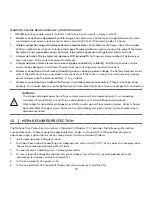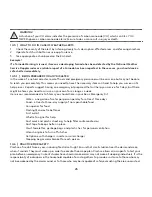
13.5 | PREVENTIVE STEPS
A CO Alarm is an excellent means of protection. It monitors the air and sounds a loud alarm before Carbon
Monoxide levels become threatening for average, healthy adults. A CO Alarm is not a substitute for proper
maintenance of home appliances. To help prevent CO problems and reduce the risk of CO poisoning:
1. Clean chimneys and flues yearly. Keep them free of debris, leaves, and nests for proper air flow. Also, have
a professional check for rust and corrosion, cracks, or separations. These conditions can prevent proper air
movement and cause back-drafting. Never “cap” or cover a chimney in any way that would block air flow.
2. Test and maintain all fuel-burning equipment annually. Many local gas or oil companies and HVAC
companies offer appliance inspections for a nominal fee.
3. Make regular visual inspections of all fuel-burning appliances. Check appliances for excessive rust and
scaling. Also check the flame on the burner and pilot lights. The flame should be blue. A yellow flame
means fuel is not being burned completely and CO may be present. Keep the blower door on the furnace
closed. Use vents or fans when they are available on all fuel-burning appliances. Make sure appliances are
vented to the outside. Do not grill or barbecue indoors, in garages, or on screen porches.
4. Check for exhaust back-flow from CO sources. Check the draft hood on an operating furnace for a
backdraft. Look for cracks on furnace heat exchangers.
5. Keep windows and doors open slightly. If you suspect that CO is escaping into your home, open a window
or a door. Opening windows and doors can significantly decrease CO levels.
13.6 | WHAT LEVELS OF CO CAUSE AN ALARM?
Underwriters Laboratories, Inc. Standard UL2034 requires residential CO Alarms to sound when exposed to
levels of CO and exposure times as described below. They are measured in parts per million (ppm) of CO over
time (in minutes).
UL2034 Required Alarm Points:
1. At 70ppm, the unit must alarm within 60-240 minutes.
2. At 150ppm, the unit must alarm within 10-50 minutes.
3. At 400ppm, the unit must alarm within 4 to 15 minutes.
This unit is designed not to alarm when exposed to a constant level of 30 ppm for 30 days.
23
WARNING
This carbon monoxide alarm is designed to detect carbon monoxide from any source of combustion.
It is NOT designed to detect any other gas.
CAUTION!
The alarm only indicates the presence of carbon monoxide gas at the sensor.
Carbon monoxide gas may be present in other areas.









































